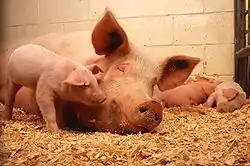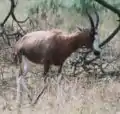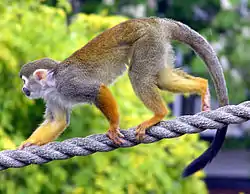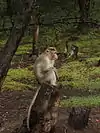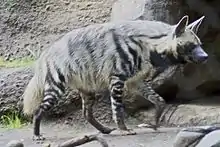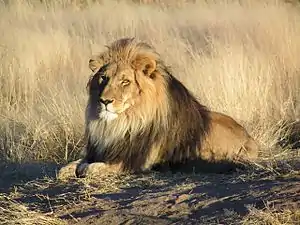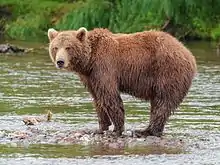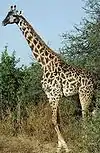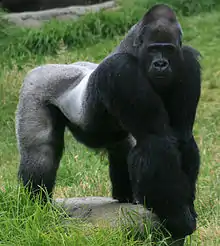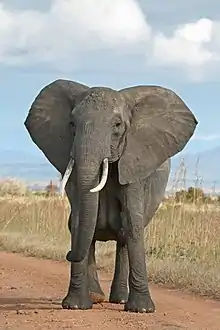List of animals by number of neurons
The following are two lists of animals ordered by the size of their nervous system. The first list shows number of neurons in their entire nervous system, indicating their overall neural complexity. The second list shows the number of neurons in the structure that has been found to be representative of animal intelligence.[1] The human brain contains 86 billion neurons, with 16 billion neurons in the cerebral cortex.[2][1]
.png.webp)
.png.webp)
Overview
Neurons are the cells that transmit information in an animal's nervous system so that it can sense stimuli from its environment and behave accordingly. Not all animals have neurons; Trichoplax and sponges lack nerve cells altogether.
Neurons may be packed to form structures such as the brain of vertebrates or the neural ganglions of insects.
The number of neurons and their relative abundance in different parts of the brain is a determinant of neural function and, consequently, of behavior.
Whole nervous system
All numbers for neurons (except Caenorhabditis and Ciona), and all numbers for synapses (except Ciona) are estimations.
Sensory-associative structure
The cerebral cortex is a structure of particular interest at the intersection between comparative neuroanatomy and comparative cognitive psychology. Historically, it had been assumed that since only mammals have a cerebral cortex, only they benefit from the information processing functions associated with it, notably awareness and thought.[58] It is now known that non-avian reptiles also have a cerebral cortex and that birds have a functional equivalent called the dorsal ventricular ridge (DVR), which in fact appears to be a modification subsequent to the reptilian cortex. A modern understanding of comparative neuroanatomy now suggests that for all vertebrates, the pallium roughly corresponds to this general sensory-associative structure.[59] It is also a widely accepted view that arthropods and closely related worms have an equivalent structure, the corpora pedunculata, more commonly known as mushroom bodies. In fact this structure in invertebrates and the pallium in vertebrates may have a common evolutionary origin from a common ancestor.[60]
Given the apparent function of the sensory-associative structure, it has been suggested that the total number of neurons in the pallium or its equivalents may be the best predictor of intelligence when comparing species, being more representative than total brain mass or volume, brain-to-body mass ratio, or encephalization quotient (EQ).[1] It may thus be reasonably assumed that the total number of neurons in an animal's corresponding sensory-associative structure strongly relates to its degree of awareness, breadth and variety of subjective experiences, and intelligence.[1]
Methods
The methods used to arrive at the numbers in this list include neuron count by isotropic fractionator, optical fractionator or estimation based on correlations observed between number of cortical neurons and brain mass within closely related taxa. Isotropic fractionation is often considered more straightforward and reliable than optical fractionation which may yield both overestimates and underestimates.[61] Estimation based on brain mass and taxon is to be considered the least reliable method.
| Common name | Average number of neurons[lower-alpha 1] | Intraspecific variation[lower-alpha 2] | Method[lower-alpha 3] | Sensory-associative structure | Binomial nomenclature | Image | Source |
|---|---|---|---|---|---|---|---|
| Common fruit fly | 2,500* | Optical fractionator | Corpora pedunculata | Drosophila melanogaster |  |
[63] | |
| House cricket | 50,000* | Optical fractionator | Corpora pedunculata | Acheta domesticus | 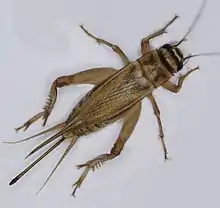 |
[63] | |
| Honey bee | 170,000* | Optical fractionator | Corpora pedunculata | Genus: Apis |  |
[63] | |
| Common cockroach | 200,000* | Optical fractionator | Corpora pedunculata | Genus: Periplaneta | 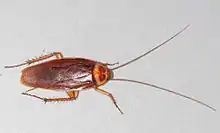 |
[63] | |
| African sheath-tailed bat | 5,000,000 | Isotropic fractionator | Pallium (cortex) | Coleura afra | [36] | ||
| Rufous trident bat | 6,000,000 | Isotropic fractionator | Pallium (cortex) | Triaenops persicus | [36] | ||
| Naked mole-rat | 6,000,000 | ± 1,065,587[38] | Isotropic fractionator | Pallium (cortex) | Heterocephalus glaber |  |
[35] |
| Little free-tailed bat | 6,000,000 | Isotropic fractionator | Pallium (cortex) | Chaerephon pumilus | 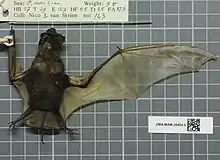 |
[36] | |
| Common bent-wing bat | 6,000,000 | Isotropic fractionator | Pallium (cortex) | Miniopterus schreibersii | [36] | ||
| Commerson's roundleaf bat | 8,000,000 | Isotropic fractionator | Pallium (cortex) | Hipposideros commersoni | _(10291616316).jpg.webp) |
[36] | |
| Heart-nosed bat | 10,000,000 | Isotropic fractionator | Pallium (cortex) | Cardioderma cor | 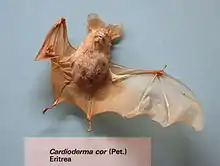 |
[36] | |
| Ansell's mole-rat | 10,000,000 | Isotropic fractionator | Pallium (cortex) | Fukomys anselli | 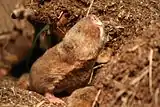 |
[41] | |
| Smoky shrew | 10,000,000 | ± 352,000[38] | Isotropic fractionator | Pallium (cortex) | Sorex fumeus | 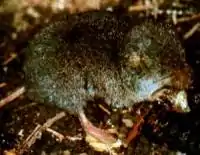 |
[38] |
| Short-palated fruit bat | 10,000,000 | Isotropic fractionator | Pallium (cortex) | Casinycteris argynnis | [36] | ||
| Mashona mole-rat | 12,000,000 | Isotropic fractionator | Pallium (cortex) | Fukomys darlingi | [41] | ||
| Woermann's bat | 12,000,000 | Isotropic fractionator | Pallium (cortex) | Megaloglossus woermanni | [36] | ||
| Northern short-tailed shrew | 12,000,000 | ± 1,569,000[38] | Isotropic fractionator | Pallium (cortex) | Blarina brevicauda | 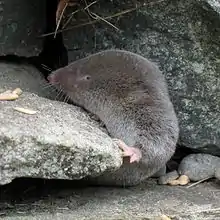 |
[38] |
| Zenker's fruit bat | 13,000,000 | Isotropic fractionator | Pallium (cortex) | Scotonycteris zenkeri | [36] | ||
| House mouse | 14,000,000 | ± 2,242,257[38] | Isotropic fractionator | Pallium (cortex) | Mus musculus |  |
[38] |
| Hairy-tailed mole | 16,000,000 | ± 2,611,000[38] | Isotropic fractionator | Pallium (cortex) | Parascalops breweri | _(7748318398).jpg.webp) |
[38] |
| Star-nosed mole | 17,000,000 | ± 3,105,000[38] | Isotropic fractionator | Pallium (cortex) | Condylura cristata |  |
[38] |
| Golden hamster | 17,000,000 | ± 3,619,934[38] | Isotropic fractionator | Pallium (cortex) | Mesocricetus auratus | 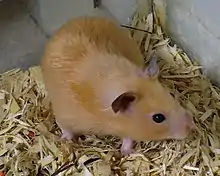 |
[38] |
| Damaraland mole-rat | 21,000,000 | Isotropic fractionator | Pallium (cortex) | Fukomys damarensis |  |
[41] | |
| Hottentot golden mole | 22,000,000 | ± 2,154,000[38] | Isotropic fractionator | Pallium (cortex) | Amblysomus hottentotus | _(8557402518).jpg.webp) |
[38] |
| Gray mouse lemur | 22,310,000 | Isotropic fractionator | Pallium (cortex) | Microcebus murinus |  |
[44] | |
| Mechow's mole-rat | 23,000,000 | Isotropic fractionator | Pallium (cortex) | Fukomys mechowii | 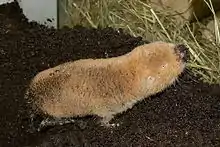 |
[41] | |
| Franquet's epauletted fruit bat | 23,000,000 | Isotropic fractionator | Pallium (cortex) | Epomops franqueti | [36] | ||
| Hammer-headed bat | 24,000,000 | Isotropic fractionator | Pallium (cortex) | Hypsignathus mostrosus | [36] | ||
| Hedgehog | 24,000,000^ | Estimated | Pallium (cortex) | Subfamily Erinaceinae, various species | 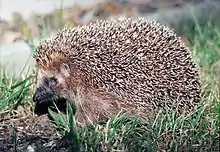 |
[64] | |
| Silvery mole-rat | 25,000,000 | Isotropic fractionator | Pallium (cortex) | Heliophobius argenteocinereus | 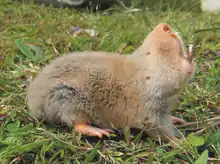 |
[41] | |
| Wahlberg's epauletted fruit bat | 26,000,000 | Isotropic fractionator | Pallium (cortex) | Epomophorus wahlbergi |  |
[36] | |
| Cape mole-rat | 26,000,000 | Isotropic fractionator | Pallium (cortex) | Georychus capensis | 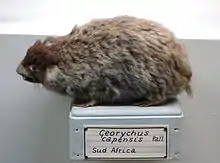 |
[41] | |
| Guyenne spiny rat | 26,000,000 | ± 2,155,723[38] | Isotropic fractionator | Pallium (cortex) | Proechimys cayennensis | [38] | |
| Eastern rock elephant shrew | 26,000,000 | ± 4,020,000[38] | Isotropic fractionator | Pallium (cortex) | Elephantulus myurus | 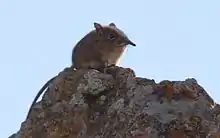 |
[38] |
| Eastern mole | 27,000,000 | ± 5,113,000[38] | Isotropic fractionator | Pallium (cortex) | Scalopus aquaticus | 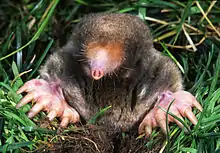 |
[38] |
| Opossum | 27,000,000^ | Estimated | Pallium (cortex) | Didelphis virginiana | 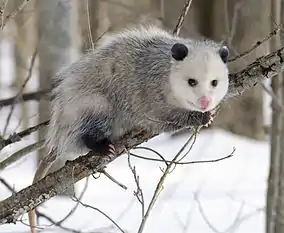 |
[64] | |
| Egyptian fruit bat | 29,000,000 | Isotropic fractionator | Pallium (cortex) | Rousettus aegyptiacus | 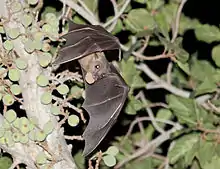 |
[36] | |
| Brown Rat | 31,000,000 | + 3,034,654[38] | Isotropic fractionator | Pallium (cortex) | Rattus norvegicus |  |
[38] |
| Four-toed elephant shrew | 34,000,000 | ± 5,840,000[38] | Isotropic fractionator | Pallium (cortex) | Petrodromus tetradactylus |  |
[38] |
| Ferret | 38,950,000 | Isotropic fractionator | Pallium (cortex) | Mustela putorius furo | [46] | ||
| Cape dune mole-rat | 43,000,000 | Isotropic fractionator | Pallium (cortex) | Bathyergus suillus |  |
[41] | |
| Guinea pig | 43,510,000 | ± 3,169,924[38] | Isotropic fractionator | Pallium (cortex) | Cavia porcellus |  |
[35] |
| Eurasian blackcap | 52,000,000 | Isotropic fractionator | Pallium (DVR) | Sylvia atricapilla | 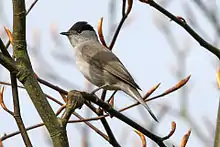 |
[42] | |
| Prairie dog | 53,770,000 | ± 6,044,322[38] | Isotropic fractionator | Pallium (cortex) | Genus:Cynomys |  |
[35] |
| Zebra finch | 55,000,000 | Isotropic fractionator | Pallium (DVR) | Taeniopygia guttata |  |
[42] | |
| Common treeshrew | 60,000,000 | ± 26,510,000[38] | Isotropic fractionator | Pallium (cortex) | Tupaia glis | 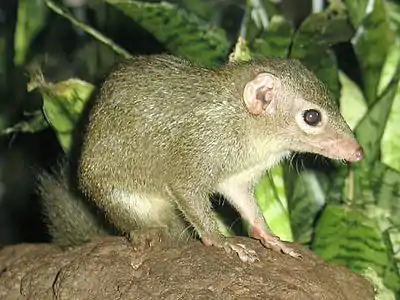 |
[38] |
| Red junglefowl | 61,000,000 | Isotropic fractionator | Pallium (DVR) | Gallus gallus | 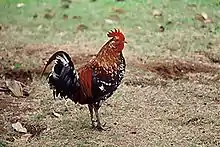 |
[42] | |
| Goldcrest | 64,000,000 | Isotropic fractionator | Pallium (DVR) | Regulus regulus |  |
[42] | |
| European rabbit | 71,450,000 | Isotropic fractionator | Pallium (cortex) | Oryctolagus cuniculus | 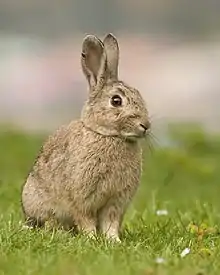 |
[35] | |
| Rock dove | 72,000,000 | Isotropic fractionator | Pallium (DVR) | Columba livia |  |
[42] | |
| Eastern gray squirrel | 77,330,000 | ± 2,634,444[38] | Isotropic fractionator | Pallium (cortex) | Sciurius carolinensis | 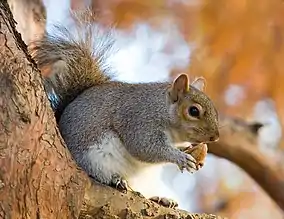 |
[35] |
| Great tit | 83,000,000 | Isotropic fractionator | Pallium (DVR) | Parus major | 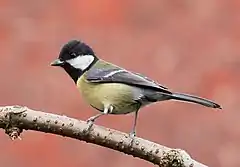 |
[42] | |
| Western tree hyrax | 99,000,000 | Isotropic fractionator | Pallium (cortex) | Dendrohyrax dorsalis | 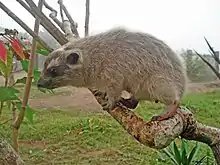 |
[38] | |
| Green-rumped parrotlet | 103,000,000 | Isotropic fractionator | Pallium (DVR) | Forpus passerinus | 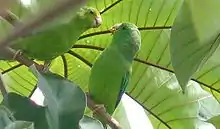 |
[42] | |
| Black-rumped agouti | 113,000,000 | ± 2,576,768[38] | Isotropic fractionator | Pallium (cortex) | Dasyprocta prymnolopha | .jpg.webp) |
[1] |
| Banded mongoose | 115,770,000 | Isotropic fractionator | Pallium (cortex) | Mungos mungo |  |
[46] | |
| Common blackbird | 136,000,000 | Isotropic fractionator | Pallium (DVR) | Turdus merula | 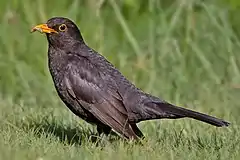 |
[42] | |
| Budgerigar | 149,000,000 | Isotropic fractionator | Pallium (DVR) | Melopsittacus undulatus | 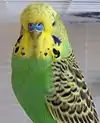 |
[42] | |
| Rock hyrax | 198,000,000 | ± 29,082,000[38] | Isotropic fractionator | Pallium (cortex) | Procavia capensis | _(7042223567).jpg.webp) |
[38] |
| Northern greater galago | 226,000,000 | ± 87,570,000[38] | Isotropic fractionator | Pallium (cortex) | Otolemur garnettii | .jpg.webp) |
[38] |
| Common starling | 226,000,000 | Isotropic fractionator | Pallium (DVR) | Sturnus vulgaris |  |
[42] | |
| Raccoon dog | 240,180,000 | Isotropic fractionator | Pallium (cortex) | Nyctereutes procyonoides | .jpg.webp) |
[49] | |
| Common marmoset | 245,000,000 | ± 81,180,000[38] | Isotropic fractionator | Pallium (cortex) | Callithrix jacchus |  |
[38] |
| House cat | 249,830,000 | Isotropic fractionator | Pallium (cortex) | Felis catus or Felis silvestris catus |  |
[46] | |
| Brown bear | 250,970,000 | Isotropic fractionator | Pallium (cortex) | Ursus arctos | _running.jpg.webp) |
[46] | |
| Cockatiel | 258,000,000 | Isotropic fractionator | Pallium (DVR) | Nymphicus hollandicus |  |
[42] | |
| Capybara | 306,500,000 | ± 62,726,120[38] | Isotropic fractionator | Pallium (cortex) | Hydrochoerus hydrochaeris |  |
[35] |
| Tarsius | 310,000,000 | Estimated | Pallium (cortex) | Genus: Tarsius, unknown species | 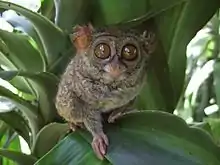 |
[65] | |
| Eastern rosella | 333,000,000 | Isotropic fractionator | Pallium (DVR) | Platycercus eximius |  |
[42] | |
| Red fox | 355,010,000 | Isotropic fractionator | Pallium (cortex) | Vulpes vulpes | 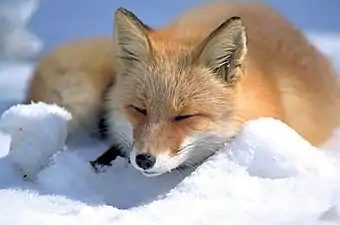 |
[49] | |
| Goeldi's marmoset | 357,130,000 | Isotropic fractionator | Pallium (cortex) | Callimico goeldii |  |
[44] | |
| Western grey kangaroo | 370,170,000 | Isotropic fractionator | Pallium (cortex) | Macropus fuliginosus | 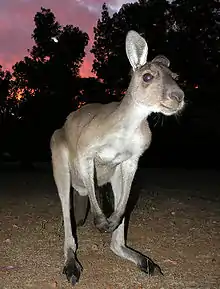 |
[66] | |
| Golden jackal | 393,620,000 | Isotropic fractionator | Pallium (cortex) | Canis aureus | 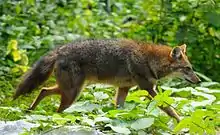 |
[49] | |
| Monk parakeet | 396,000,000 | Isotropic fractionator | Pallium (DVR) | Myiopsitta monachus |  |
[42] | |
| Springbok | 396,900,000 | Isotropic fractionator | Pallium (cortex) | Antidorcas marsupialis |  |
[50] | |
| Azure-winged magpie | 400,000,000 | Isotropic fractionator | Pallium (DVR) | Cyanopica cyanus |  |
[42] | |
| Common hill myna | 410,000,000 | Isotropic fractionator | Pallium (DVR) | Gracula religiosa | 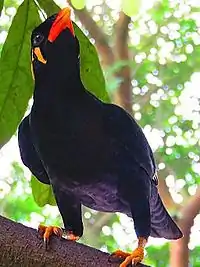 |
[42] | |
| Domesticated pig | 425,000,000* | Optical fractionator | Pallium (cortex) | Sus scrofa domesticus | 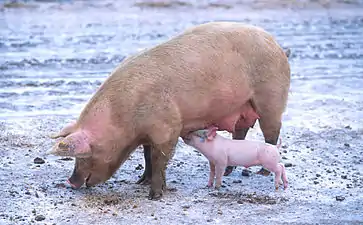 |
[67] | |
| Barn owl | 437,000,000 | Isotropic fractionator | Pallium (DVR) | Tyto alba |  |
[42] | |
| Emu | 439,000,000 | Isotropic fractionator | Pallium (DVR) | Dromaius novaehollandiae |  |
[42] | |
| West Highland White Terrier | 440,160,000 | Isotropic fractionator | Pallium (cortex) | Canis lupus familiaris |  |
[49] | |
| Three-striped night monkey | 442,000,000 | ± 111,310,000[38] | Isotropic fractionator | Pallium (cortex) | Aotus trivirgatus |  |
[1] |
| Eurasian magpie | 443,000,000 | Isotropic fractionator | Pallium (DVR) | Pica pica |  |
[42] | |
| Raccoon | 453,000,000 | Isotropic fractionator | Pallium (cortex) | Procyon lotor | .jpg.webp) |
[68] | |
| Chow Chow | 471,500,000 | Isotropic fractionator | Pallium (cortex) | Canis lupus familiaris |  |
[49] | |
| Western jackdaw | 492,000,000 | Isotropic fractionator | Pallium (DVR) | Coloeus monedula | 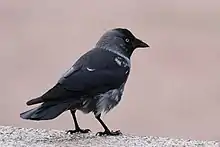 |
[42] | |
| Striped hyena | 495,280,000 | Isotropic fractionator | Pallium (cortex) | Hyaena hyaena |  |
[46] | |
| Chihuhua | 513,330,000 | Isotropic fractionator | Pallium (cortex) | Canis lupus familiaris |  |
[49] | |
| Eurasian jay | 529,000,000 | Isotropic fractionator | Pallium (DVR) | Garrulus glandarius |  |
[42] | |
| Lion | 545,240,000 | Isotropic fractionator | Pallium (cortex) | Panthera leo | 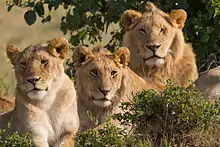 |
[46] | |
| Blesbok | 570,670,000 | Isotropic fractionator | Pallium (cortex) | Damaliscus pygargus phillipsi |  |
[50] | |
| Yorkshire Terrier | 572,140,000 | Isotropic fractionator | Pallium (cortex) | Canis lupus familiaris |  |
[49] | |
| Alexandrine parakeet | 575,000,000 | Isotropic fractionator | Pallium (DVR) | Psittacula eupatria | %252C_Jurong_Bird_Park%252C_Singapore_-_20090613.jpg.webp) |
[42] | |
| Tanimbar corella | 599,000,000 | Isotropic fractionator | Pallium (DVR) | Cacatua goffiniana | 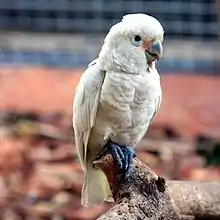 |
[42] | |
| Golden retriever | 627,000,000 | Isotropic fractionator | Pallium (cortex) | Canis lupus familiaris | .jpg.webp) |
[46] | |
| Gracile capuchin monkey | 650,000,000^ | Estimated | Pallium (cortex) | Genus: Cebus | 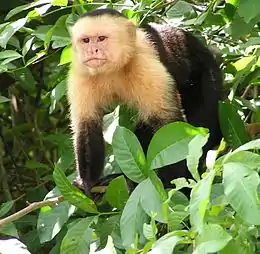 |
[61] | |
| Transylvanian Hound | 725,760,000 | Isotropic fractionator | Pallium (cortex) | Canis lupus familiaris |  |
[49] | |
| Greater kudu | 762,570,000 | Isotropic fractionator | Pallium (cortex) | Tragelaphus strepsiceros | 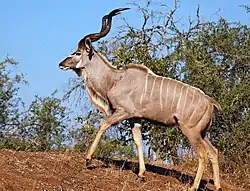 |
[50] | |
| Crab-eating macaque | 800,960,000 | Isotropic fractionator | Pallium (cortex) | Macaca fascicularis |  |
[44] | |
| Rook | 820,000,000 | Isotropic fractionator | Pallium (DVR) | Corvus frugilegus |  |
[42] | |
| Beagle | 844,410,000 | Isotropic fractionator | Pallium (cortex) | Canis lupus familiaris |  |
[49] | |
| Grey parrot | 850,000,000 | Isotropic fractionator | Pallium (DVR) | Psittacus erithacus |  |
[42] | |
| Komondor | 883,380,000 | Isotropic fractionator | Pallium (cortex) | Canis lupus familiaris | 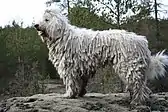 |
[49] | |
| German Shepherd | 885,460,000 | Isotropic fractionator | Pallium (cortex) | Canis lupus familiaris |  |
[49] | |
| Sulphur-crested cockatoo | 1,135,000,000 | Isotropic fractionator | Pallium (DVR) | Cacatua galerita | 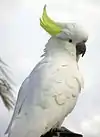 |
[42] | |
| Tufted capuchin | 1,140,000,000 | Isotropic fractionator | Pallium (cortex) | Sapajus apella | _4.jpg.webp) |
[38][1] | |
| Harp seal | 1,168,000,000^
6,100,000,000* |
Estimated
Optical fractionator |
Pallium (cortex) | Pagophilus groenlandicus |  |
[69][70] | |
| Horse | 1,200,000,000* | Optical fractionator | Pallium (cortex) | Equus ferus caballus | 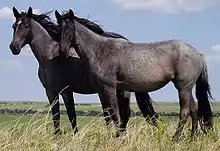 |
[71] | |
| Raven | 1,204,000,000 | Isotropic fractionator | Pallium (DVR) | Corvus corax |  |
[42] | |
| Kea | 1,281,000,000 | Isotropic fractionator | Pallium (DVR) | Nestor notabilis | 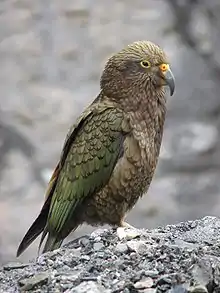 |
[42] | |
| Common squirrel monkey | 1,340,000,000 | ± 20,000,000[38] | Isotropic fractionator | Pallium (cortex) | Saimiri sciureus |  |
[38] |
| Bonnet macaque | 1,660,000,000 | Isotropic fractionator | Pallium (cortex) | Macaca radiata | .jpg.webp) |
[44] | |
| Rhesus macaque | 1,710,000,000 | Isotropic fractionator | Pallium (cortex) | Macaca mulatta | 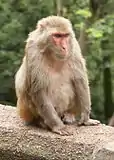 |
[38] | |
| Giraffe | 1,731,000,000 | Isotropic fractionator | Pallium (cortex) | Giraffa camelopardalis |  |
[50] | |
| Blue and yellow macaw | 1,900,000,000 | Isotropic fractionator | Pallium (DVR) | Ara ararauna | _Weltvogelpark_Walsrode_2010.jpg.webp) |
[42] | |
| Pygmy sperm whale | 2,020,000,000* | Optical fractionator | Pallium (cortex) | Kogia breviceps |  |
[72] | |
| Leopard seal | 2,386,000,000^ | Estimated | Pallium (cortex) | Hydrurga leptonyx |  |
[69] | |
| Guenon | 2,500,000,000^ | Estimated | Pallium (cortex) | Genus: Cercopithecus, unknown species |  |
[65] | |
| Pigtail Macaque | 2,531,000,000^ | Estimated | Pallium (cortex) | Macaca nemestrina | 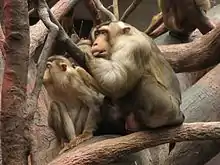 |
[69] | |
| Gelada baboon | 2,568,000,000^ | Estimated | Pallium (cortex) | Theropithecus gelada | _juvenile_male.jpg.webp) |
[69] | |
| Red-and-green macaw | 2,646,000,000^ | Estimated | Pallium (DVR) | Ara chloropterus | 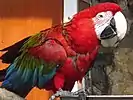 |
[69] | |
| Harbor porpoise | 2,750,000,000* | Optical fractionator | Pallium (cortex) | Phocoena phocoena | .jpg.webp) |
[69][70] | |
| Yellow baboon | 2,880,000,000 | Isotropic fractionator | Pallium (cortex) | Papio cynocephalus |  |
[44] | |
| Hyacinth macaw | 2,944,000,000^ | Estimated | Pallium (DVR) | Anodorhynchus hyacinthinus | _feeding_on_palm_nuts_..._-_Flickr_-_berniedup.jpg.webp) |
[69] | |
| Hamadryas baboon | 2,990,000,000^ | Estimated | Pallium (cortex) | Papio hamadryas | _female.jpg.webp) |
[69] | |
| Mandrill | 3,102,000,000^ | Estimated | Pallium (cortex) | Mandrillus sphinx | %252C_Berlin_Zoo.jpg.webp) |
[69] | |
| Walrus | 3,929,000,000^ | Estimated | Pallium (cortex) | Odobenus rosmarus | 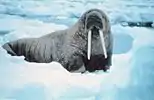 |
[69] | |
| Southern elephant seal | 3,994,000,000^ | Estimated | Pallium (cortex) | Mirounga leonina | .jpg.webp) |
[69] | |
| African elephant | 5,600,000,000 | Isotropic fractionator | Pallium (cortex) | Loxodonta africana | 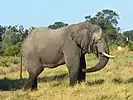 |
[56] | |
| Short-beaked common dolphin | 6,700,000,000* | Optical fractionator | Pallium (cortex) | Delphinus delphis | _(14825276609).jpg.webp) |
[69][72] | |
| Asian elephant | 6,775,000,000^ | Estimated | Pallium (cortex) | Elephas maximus |  |
[69] | |
| Pygmy chimpanzee or bonobo | 7,250,000,000^ | Estimated | Pallium (cortex) | Pan paniscus |  |
[69] | |
| Chimpanzee | 7,400,000,000* | Optical fractionator | Pallium (cortex) | Pan troglodytes | _(7068198095)_(cropped).jpg.webp) |
[73] | |
| Orangutan | 7,704,000,000^ - 8,900,000,000^ | Estimated | Pallium (cortex) | Genus: Pongo | 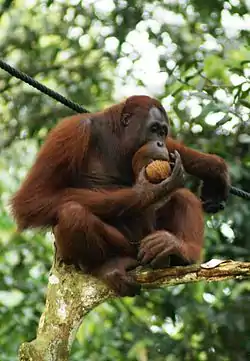 |
[69][52] | |
| Western gorilla | 9,100,000,000^ | Estimated | Pallium (cortex) | Gorilla gorilla |  |
[69][52] | |
| Cuvier's beaked whale | 9,100,000,000* | Optical fractionator | Pallium (cortex) | Ziphius cavirostris | .jpg.webp) |
[72] | |
| Beluga whale | 10,000,000,000^ | Estimated | Pallium (cortex) | Delphinapterus leucas |  |
[69] | |
| Bottlenose dolphin | 12,700,000,000* | Optical fractionator | Pallium (cortex) | Tursiops truncatus |  |
[69][72] | |
| Common minke whale | 12,800,000,000* | Optical fractionator | Pallium (cortex) | Balaenoptera acutorostrata | .jpg.webp) |
[74] | |
| Fin whale | 15,000,000,000* | Optical fractionator | Pallium (cortex) | Balaenoptera physalus | 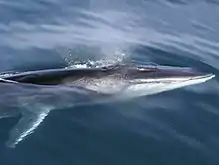 |
[69][75] | |
| Blue whale | 15,000,000,000^ | Estimated | Pallium (cortex) | Balaenoptera musculus | 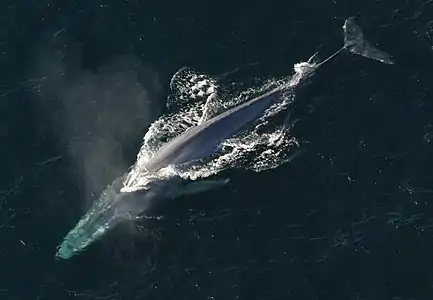 |
[69] | |
| Human | 16,340,000,000
21,000,000,000* |
± 2,170,000,000[38] | Isotropic fractionator
Optical fractionator |
Pallium (cortex) | Homo sapiens |  |
[38][53][1][76][77] |
| Risso's dolphin | 18,750,000,000^ | Estimated | Pallium (cortex) | Grampus griseus | 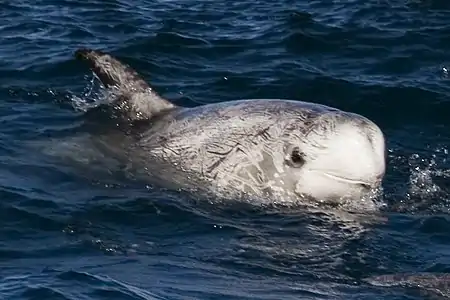 |
[69] | |
| Short-finned pilot whale | 35,000,000,000^ | Estimated | Pallium (cortex) | Globicephala macrorhynchus | _(8604841637).jpg.webp) |
[69] | |
| Long-finned pilot whale | 37,200,000,000* | Optical fractionator | Pallium (cortex) | Globicephala melas | 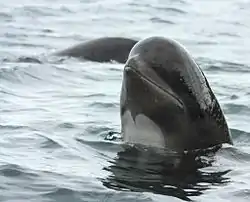 |
[78] | |
| Killer whale | 43,100,000,000* | Optical fractionator | Pallium (cortex) | Orcinus orca |  |
[69][72] |
See also
Notes
- ^ = Estimated
- = Optical fractionator
- ± standard deviation
- For the estimated values, the number of cortical neurons estimated from brain mass for different mammalian and bird orders are based on correlation observed between number of cortical neuron and brain mass per order[62]
References
- Herculano-Houzel, Suzana (9 November 2009). "The human brain in numbers: a linearly scaled-up primate brain". Frontiers in Human Neuroscience. 3: 31. doi:10.3389/neuro.09.031.2009. PMC 2776484. PMID 19915731.
- https://www.theguardian.com/science/blog/2012/feb/28/how-many-neurons-human-brain
- Sherwood L, Klandorf H and Yancey P (2012) Animal Physiology: From Genes to Organisms Cengage Learning, p. 150. ISBN 9781133709510.
- https://www.youtube.com/watch?v=z4eqSl7Vups
- Schierwater B (December 2005). "My favorite animal, Trichoplax adhaerens". BioEssays. 27 (12): 1294–1302. doi:10.1002/bies.20320. PMID 16299758.
- Ware, Randle W.; LoPresti, Vincent (1975). "Three-dimensional reconstruction from serial sections". Int. Rev. Cytol. International Review of Cytology. 40: 325–440. doi:10.1016/S0074-7696(08)60956-0. ISBN 9780123643407. PMID 1097356.
- Martin C, Gross V, Hering L, Mayer G (2017). "The nervous and visual systems of onychophorans and tardigrades: learning about arthropod evolution from their closest relatives". Journal of Comparative Physiology A. 203 (8): 565–590. doi:10.1007/s00359-017-1186-4. PMID 28600600. S2CID 25280904.
- Ryan, Kerrianne; Lu, Zhiyuan; Meinertzhagen, Ian A. (2016). "The CNS connectome of a tadpole larva of Ciona intestinalis (L.) highlights sidedness in the brain of a chordate sibling". eLife. 2016, 5:e16962: e16962. doi:10.7554/eLife.16962. PMC 5140270. PMID 27921996.
- Ryan, Kerrianne; Lu, Zhiyuan; Meinertzhagen, Ian A. (2018). "The peripheral nervous system of the ascidian tadpole larva: Types of neurons and their synaptic networks". Journal of Comparative Neurology. 526 (4): 583–608. doi:10.1002/cne.24353. PMID 29124768. S2CID 20052591.
- White JG, Southgate E, Thomson JN, Brenner S (November 1986). "The structure of the nervous system of the nematode Caenorhabditis elegans". Philosophical Transactions of the Royal Society of London. Series B, Biological Sciences. 314 (1165): 1–340. Bibcode:1986RSPTB.314....1W. doi:10.1098/rstb.1986.0056. PMID 22462104.
- White JG (June 2013). "Getting into the mind of a worm--a personal view". WormBook: 1–10. doi:10.1895/wormbook.1.158.1. PMC 4781474. PMID 23801597.
- Jabr F (2012-10-02). "The Connectome Debate: Is Mapping the Mind of a Worm Worth It?". Scientific American. Retrieved 2014-01-18.
- White, J. G; E. Southgate; J. N Thomson; S. Brenner (1986-11-12). "The Structure of the Nervous System of the Nematode Caenorhabditis Elegans". Philosophical Transactions of the Royal Society B. 314 (1165): 1–340. Bibcode:1986RSPTB.314....1W. doi:10.1098/rstb.1986.0056. ISSN 0962-8436. PMID 22462104. S2CID 5006466.
- Bode, H.; Berking, S.; David, C. N.; Gierer, A.; Schaller, H.; Trenkner, E. (1973). "Quantitative analysis of cell types during growth and morphogenesis in Hydra". Wilhelm Roux Archiv für Entwicklungsmechanik der Organismen (Submitted manuscript). 171 (4): 269–285. doi:10.1007/BF00577725. ISSN 0949-944X. PMID 28304608. S2CID 5484431.
- Polilov, Alexey A. (2011). "The smallest insects evolve anucleate neurons". Arthropod Structure & Development. 41 (1): 29–34. doi:10.1016/j.asd.2011.09.001. PMID 22078364.
- Garm, A.; Poussart, Y.; Parkefelt, L.; Ekström, P.; Nilsson, D-E. (2007). "The ring nerve of the box jellyfish Tripedalia cystophora". Cell and Tissue Research. 329 (1): 147–157. doi:10.1007/s00441-007-0393-7. ISSN 0302-766X. PMID 17340150. S2CID 26982210.
- Kuffler SW, Potter DD (1964). "Glia in the leech central nervous system: physiological properties and neuron-glia relationship". J. Neurophysiol. 27 (2): 290–320. doi:10.1152/jn.1964.27.2.290. PMID 14129773.
- Roth G, Dicke U (May 2005). "Evolution of the brain and intelligence". Trends Cogn. Sci. (Regul. Ed.). 9 (5): 250–7. doi:10.1016/j.tics.2005.03.005. PMID 15866152. S2CID 14758763. as PDF Archived 2009-07-31 at the Wayback Machine
- Cash D, Carew TJ (1989). "A quantitative analysis of the development of the central nervous system in juvenile Aplysia californica". J Neurobiol. 20 (1): 25–47. doi:10.1002/neu.480200104. PMID 2921607.CS1 maint: uses authors parameter (link)
- Roth, Gerhard (3 June 2013). The Long Evolution of Brains and Minds. Springer Science & Business Media. p. 121. ISBN 978-94-007-6259-6. Retrieved 9 December 2015.
- Aniszewski, Tadeusz (25 April 2015). Alkaloids: Chemistry, Biology, Ecology, and Applications. Elsevier Science. p. 316. ISBN 978-0-444-59462-4. Retrieved 9 December 2015.
- Scientists Capture All The Neurons Firing Across A Fish's Brain On Video Popular Science, 19 March 2013.
- "Anatomy & Biology". The Lobster Institute. University of Maine. Archived from the original on February 8, 2018. Retrieved March 19, 2016.
- https://www.wired.com/story/most-complete-brain-map-ever-is-here-a-flys-connectome/
- Lagercrantz, Hugo; Hanson, M. A.; Ment, Laura R.; Peebles, Donald M., eds. (7 January 2010). The Newborn Brain: Neuroscience and Clinical Applications. Cambridge University Press. p. 3. ISBN 978-1-139-48558-6. Retrieved 9 December 2015.
- Nass, Richard; Przedborski, Serge (28 April 2011). Parkinson's Disease: molecular and therapeutic insights from model systems. Academic Press. p. 325. ISBN 978-0-08-055958-2. Retrieved 9 December 2015.
- John and Sarah Tefl. "Interesting Facts About Ants". Retrieved December 23, 2010.
- Menzel R, Giurfa M (February 2001). "Cognitive architecture of a mini-brain: the honeybee". Trends Cogn. Sci. 5 (2): 62–71. doi:10.1016/S1364-6613(00)01601-6. PMID 11166636. S2CID 3202685.
- "A Strange Approach to Social Interaction, and Butterflies". Anthropology.net. January 10, 2007. Archived from the original on January 13, 2007. Retrieved November 26, 2010.
- Storks, Levi; Powell, Brian J.; Leal, Manuel (2020). "Peeking inside the lizard brain: Neuron numbers in Anolis and its implications for cognitive performance and vertebrate brain evolution". Integrative and Comparative Biology. doi:10.1093/icb/icaa129. PMID 33175153.
- Marhounová, Lucie; Kotrschal, Alexander; Kverková, Kristina; Kolm, Niclas; Němec, Pavel (2019). "Artificial selection on brain size leads to matching changes in overall number of neurons". Evolution. 0 (9): 2003–2012. doi:10.1111/evo.13805. ISSN 1558-5646. PMC 6772110. PMID 31339177.
- Kverková, Kristina; Polonyiová, Alexandra; Kubička, Lukáš; Němec, Pavel (2020-09-30). "Individual and age-related variation of cellular brain composition in a squamate reptile". Biology Letters. 16 (9): 20200280. doi:10.1098/rsbl.2020.0280. PMC 7532707. PMID 32961085.
- Hinsch, K. & Zupanc, G. K. H. (2007). "Generation and long-term persistence of new neurons in the adult zebrafish brain: A quantitative analysis". Neuroscience. 146 (2): 679–696. doi:10.1016/j.neuroscience.2007.01.071. PMID 17395385. S2CID 5643696.
- "Frog Brain Neuron Number". Archived from the original on 16 July 2015. Retrieved 15 July 2015.
- Herculano-Houzel, Suzana; Ribeiro, Pedro; Campos, Leandro; Silva, Alexandre Valotta da; Torres, Laila B.; Catania, Kenneth C.; Kaas, Jon H. (2011). "Updated Neuronal Scaling Rules for the Brains of Glires (Rodents/Lagomorphs)". Brain, Behavior and Evolution. 78 (4): 302–314. doi:10.1159/000330825. ISSN 0006-8977. PMC 3237106. PMID 21985803.
- Herculano‐Houzel, Suzana; Cunha, Felipe Barros da; Reed, Jamie L.; Kaswera‐Kyamakya, Consolate; Gillissen, Emmanuel; Manger, Paul R. (2020). "Microchiropterans have a diminutive cerebral cortex, not an enlarged cerebellum, compared to megachiropterans and other mammals". Journal of Comparative Neurology. n/a (n/a): 2978–2993. doi:10.1002/cne.24985. ISSN 1096-9861. PMID 32656795. S2CID 220499352.
- Hofman, Michel A.; Falk, Dean (2 March 2012). Evolution of the Primate Brain: From Neuron to Behavior. Elsevier. p. 425. ISBN 978-0-444-53860-4.
- name="H-Houzel2015"Herculano-Houzel, Suzana; Catania, Kenneth; Manger, Paul R.; Kaas, Jon H. (2015). "Mammalian Brains Are Made of These: A Dataset of the Numbers and Densities of Neuronal and Nonneuronal Cells in the Brain of Glires, Primates, Scandentia, Eulipotyphlans, Afrotherians and Artiodactyls, and Their Relationship with Body Mass" (PDF). Brain, Behavior and Evolution. S. Karger AG. 86 (3–4): 145–163. doi:10.1159/000437413. ISSN 0006-8977. PMID 26418466. S2CID 10637829.
- Herculano-Houzel S, Mota B, Lent R (2006). "Cellular scaling rules for rodent brains". Proc Natl Acad Sci USA. 103 (32): 12138–12143. Bibcode:2006PNAS..10312138H. doi:10.1073/pnas.0604911103. PMC 1567708. PMID 16880386.
- Ngwenya, Ayanda; Patzke, Nina; Manger, Paul R.; Herculano-Houzel, Suzana (2016). "Continued Growth of the Central Nervous System without Mandatory Addition of Neurons in the Nile Crocodile (Crocodylus niloticus)". Brain, Behavior and Evolution. 87 (1): 19–38. doi:10.1159/000443201. PMID 26914769. S2CID 5353731.
- Kverková, Kristina; Bělíková, Tereza; Olkowicz, Seweryn; Pavelková, Zuzana; O’Riain, M. Justin; Šumbera, Radim; Burda, Hynek; Bennett, Nigel C.; Němec, Pavel (2018-06-15). "Sociality does not drive the evolution of large brains in eusocial African mole-rats". Scientific Reports. 8 (1): 9203. Bibcode:2018NatSR...8.9203K. doi:10.1038/s41598-018-26062-8. ISSN 2045-2322. PMC 6003933. PMID 29907782.
- Olkowicz, Seweryn; Kocourek, Martin; Lučan, Radek K.; Porteš, Michal; Fitch, W. Tecumseh; Herculano-Houzel, Suzana; Němec, Pavel (2016). "Birds have primate-like numbers of neurons in the forebrain". Proceedings of the National Academy of Sciences. 113 (26): 7255–60. doi:10.1073/pnas.1517131113. ISSN 0027-8424. PMC 4932926. PMID 27298365.
- Herculano-Houzel, S. & Lent, R. (2005). "Isotropic fractionator: a simple, rapid method for the quantification of total cell and neuron numbers in the brain". J Neurosci. 25 (10): 2518–2521. doi:10.1523/jneurosci.4526-04.2005. PMC 6725175. PMID 15758160.
- Gabi, Mariana; Collins, Christine E.; Wong, Peiyan; Torres, Laila B.; Kaas, Jon H.; Herculano-Houzel, Suzana (2010). "Cellular Scaling Rules for the Brains of an Extended Number of Primate Species". Brain, Behavior and Evolution. 76 (1): 32–44. doi:10.1159/000319872. ISSN 0006-8977. PMC 2980814. PMID 20926854.
- Herculano-Houzel S, Collins C, Wong P, Kaas J (2007). "Cellular scaling rules for primate brains". Proc Natl Acad Sci USA. 104 (9): 3562–3567. Bibcode:2007PNAS..104.3562H. doi:10.1073/pnas.0611396104. PMC 1805542. PMID 17360682.
- Jardim-Messeder, Débora; Lambert, Kelly; Noctor, Stephen; Pestana, Fernanda M.; Leal, de Castro; E, Maria; Bertelsen, Mads F.; Alagaili, Abdulaziz N.; Mohammad, Osama B. (2017). "Dogs Have the Most Neurons, Though Not the Largest Brain: Trade-Off between Body Mass and Number of Neurons in the Cerebral Cortex of Large Carnivoran Species". Frontiers in Neuroanatomy. 11: 118. doi:10.3389/fnana.2017.00118. ISSN 1662-5129. PMC 5733047. PMID 29311850.
- "Brain Facts and Figures". Retrieved 15 July 2015.
- Ananthanarayanan, Rajagopal; Esser, Steven K.; Simon, Horst D.; Modha, Dharmendra S. (2009). "The cat is out of the bag: cortical simulations with 109 neurons, 1013 synapses". Proceedings of the Conference on High Performance Computing Networking, Storage and Analysis - SC '09. pp. 1–12. doi:10.1145/1654059.1654124. ISBN 978-1-60558-744-8. S2CID 6110450.
- Salajková, Veronika (2020-02-03). "Pravidla buněčného škálování mozku u psů: Efekt domestikace a miniaturizace psích plemen" (in Czech). Cite journal requires
|journal=(help) - Kazu, Rodrigo S.; Maldonado, José; Mota, Bruno; Manger, Paul R.; Herculano-Houzel, Suzana (2015). "Corrigendum: Cellular scaling rules for the brain of Artiodactyla include a highly folded cortex with few neurons". Frontiers in Neuroanatomy. 9: 39. doi:10.3389/fnana.2015.00039. ISSN 1662-5129. PMC 4374476. PMID 25859187.
- Herculano-Houzel, Suzana (June 2012). "The remarkable, yet not extraordinary, human brain as a scaled-up primate brain and its associated cost". Proceedings of the National Academy of Sciences. 109 Suppl 1: 10661–8. doi:10.1073/pnas.1201895109. PMC 3386878. PMID 22723358.
- Herculano-Houzel, Suzana; Kaas, Jon (2011). "Gorilla and Orangutan Brains Conform to the Primate Cellular Scaling Rules: Implications for Human Evolution". Brain Behav Evol. 77 (1): 33–44. doi:10.1159/000322729. PMC 3064932. PMID 21228547.
- Azevedo, Frederico A.C.; Carvalho, Ludmila R.B.; Grinberg, Lea T.; Farfel, José Marcelo; Ferretti, Renata E.L.; Leite, Renata E.P.; Filho, Wilson Jacob; Lent, Roberto; Herculano-Houzel, Suzana (2009). "Equal numbers of neuronal and nonneuronal cells make the human brain an isometrically scaled-up primate brain". The Journal of Comparative Neurology. 513 (5): 532–541. doi:10.1002/cne.21974. PMID 19226510. S2CID 5200449.
- Herculano-Houzel, S. (20 June 2012). "The remarkable, yet not extraordinary, human brain as a scaled-up primate brain and its associated cost". Proceedings of the National Academy of Sciences. 109 (Supplement_1): 10661–10668. doi:10.1073/pnas.1201895109. PMC 3386878. PMID 22723358.
- TOWER DB. (1954). "Structural and functional organization of mammalian cerebral cortex; the correlation of neurone density with brain size; cortical neurone density in the fin whale (Balaenoptera physalus L.) with a note on the cortical neurone density in the Indian elephant". The Journal of Comparative Neurology. 101 (1): 19–51. doi:10.1002/cne.901010103. PMID 13211853. S2CID 10396499.
- Herculano-Houzel, S; Avelino-de-Souza, K; Neves, K; Porfírio, J; Messeder, D; Mattos Feijó, L; Maldonado, J; Manger, PR (2014). "The Elephant Brain in Numbers". Front Neuroanat. 8: 46. doi:10.3389/fnana.2014.00046. PMC 4053853. PMID 24971054.
- "Searching For The Elephant's Genius Inside the Largest Brain on Land". Scientificamerica. 26 February 2014.
- MacLean, P.D. (Jan 31, 1990). The Triune Brain in Evolution: Role in Paleocerebral Functions. Springer Science & Business Media. p. 10. ISBN 9780306431685. Retrieved 21 May 2020.
- Finger, Thomas E.; Yamamoto, Naoyuki; Karten, Harvey J.; Hof, Patrick R. (2013). "Evolution of the forebrain — revisiting the pallium". Journal of Comparative Neurology. Wiley Periodicals, Inc. 521 (16): 3601–3603. doi:10.1002/cne.23444. PMID 23893869. S2CID 5062781.
- Tomer, Raju; Denes, Alexandru S.; Tessmar-Raible, Kristin; Arendt, Detlev (September 3, 2010). "Profiling by Image Registration Reveals Common Origin of Annelid Mushroom Bodies and Vertebrate Pallium". Cell. 142 (5): 800–809. doi:10.1016/j.cell.2010.07.043. PMID 20813265. S2CID 917306.
- Hofman, Michel A.; Falk, Dean (2 March 2012). Evolution of the Primate Brain: From Neuron to Behavior. Elsevier. p. 424. ISBN 978-0-444-53867-3.
- Heisenberg, Martin (May 1998). "What Do the Mushroom Bodies Do for the Insect Brain? An Introduction". Learning & Memory. 5 (1): 1–10. PMC 311238. PMID 10454369.
- Fasolo, Aldo (30 November 2011). The Theory of Evolution and Its Impact. Springer. p. 182. ISBN 978-88-470-1973-7.
- Quarton, Gardner C.; Melnechuk, Theodore; Schmitt, Francis O. (1967). The neurosciences. Rockefeller University Press. p. 732. GGKEY:DF21HXQKLNX.
- Dos Santos, S.E.; Porfirio, J.; da Cunha, F.B.; Manger, P.R.; Tavares, W.; Pessoa, L.; Raghanti, M.A.; Sherwood, C.C.; Herculano-Houzel, S. (2017). "Cellular scaling rules for the brains of marsupials: Not as "primitive" as expected". Brain, Behavior and Evolution. 89 (1): 48–63. doi:10.1159/000452856. PMID 28125804. Table S1: Cellular composition of the Marsupial brains.
- "LEARNING FROM PIG BRAINS". Retrieved 15 July 2015.
- Lambert KG, Bardi M, Landis T, Hyer MM, Rzucidlo A, Gehrt S, Anchor C, Jardim Messeder D, Herculano-Houzel S (2014). "Behind the Mask: Neurobiological indicants of emotional resilience and cognitive function in wild raccoons (Procyon lotor)". Society for Neuroscienc.
- Herculano‐Houzel, Suzana (2019). "Longevity and sexual maturity vary across species with number of cortical neurons, and humans are no exception". Journal of Comparative Neurology. 527 (10): 1689–1705 Supporting Information Table S1. doi:10.1002/cne.24564. ISSN 0021-9967. PMID 30350858. S2CID 53033539.
- Walløe, Solveig; Eriksen, Nina; Dabelsteen, Torben; Pakkenberg, Bente (2010-12-01). "A neurological comparative study of the harp seal (Pagophilus groenlandicus) and harbor porpoise (Phocoena phocoena) brain". Anatomical Record. 293 (12): 2129–2135. doi:10.1002/ar.21295. ISSN 1932-8494. PMID 21077171. S2CID 2636107.
- Haug, Herbert (October 1987). "Brain sizes, surfaces, and neuronal sizes of the cortex cerebri: A stereological investigation of man and his variability and a comparison with some mammals (primates, whales, marsupials, insectivores, and one elephant)". American Journal of Anatomy. 180 (2): 126–142. doi:10.1002/aja.1001800203. ISSN 0002-9106. PMID 3673918.
- Ridgway, Sam H.; Brownson, Robert H.; Alstyne, Kaitlin R. Van; Hauser, Robert A. (2019-12-16). "Higher neuron densities in the cerebral cortex and larger cerebellums may limit dive times of delphinids compared to deep-diving toothed whales". PLOS ONE. 14 (12): e0226206. Bibcode:2019PLoSO..1426206R. doi:10.1371/journal.pone.0226206. ISSN 1932-6203. PMC 6914331. PMID 31841529.
- Kaas, Jon (4 January 2015). "Cortical cell and neuron density estimates in one chimpanzee hemisphere". PNAS. 113 (3): 740–5. doi:10.1073/pnas.1524208113. PMC 4725503. PMID 26729880.
- Eriksen, Nina; Pakkenberg, Bente (2007-01-01). "Total neocortical cell number in the mysticete brain". Anatomical Record. 290 (1): 83–95. doi:10.1002/ar.20404. ISSN 1932-8486. PMID 17441201. S2CID 31374672.
- Mammals, Food and Agriculture Organization of the United Nations Working Party on Marine (1978-01-01). Mammals in the Seas: Report. Food & Agriculture Org. ISBN 9789251005132.
- Steven M. Platek; Julian Paul Keenan & Todd K. Shackelford (2009). "Evolutionary Cognitive Neuroscience" (PDF): 139. Cite journal requires
|journal=(help) - Pakkenberg, Bente; Gunderson, Hans Jorgen G. (1997). "Neocortical neuron number in humans: Effect of sex and age". The Journal of Comparative Neurology. Wiley‐Liss, Inc. 384 (2): 312–320. doi:10.1002/(SICI)1096-9861(19970728)384:2<312::AID-CNE10>3.0.CO;2-K. PMID 9215725.
- Mortensen HS, et al. (2014). "Quantitative relationships in delphinid neocortex". Front Neuroanat. 8: 132. doi:10.3389/fnana.2014.00132. PMC 4244864. PMID 25505387.
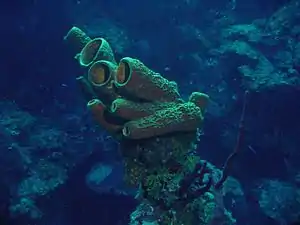
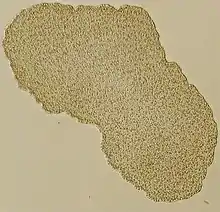
_-_40X_view.jpg.webp)
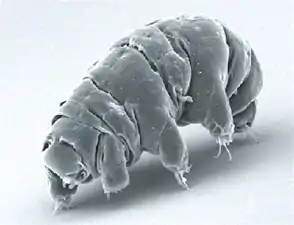

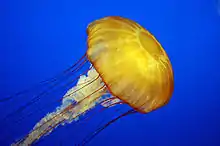
.tif.jpg.webp)
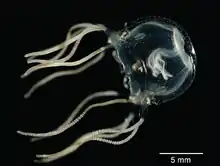

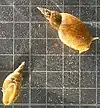
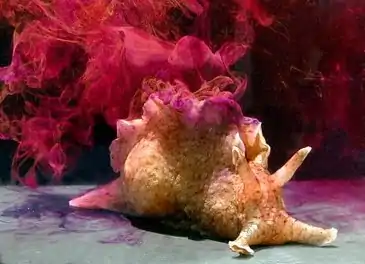

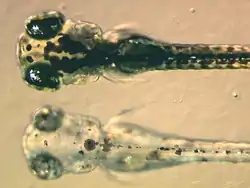

.jpg.webp)
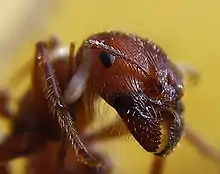
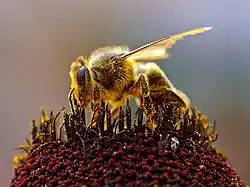


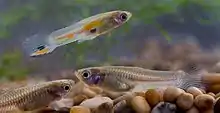

_crop.jpg.webp)

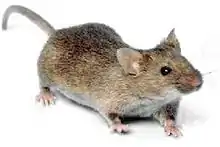
.jpg.webp)

.jpg.webp)
.jpg.webp)


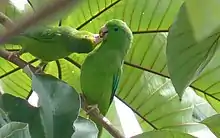
.jpg.webp)
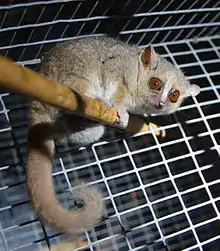
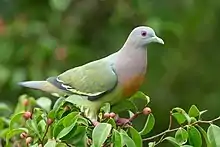

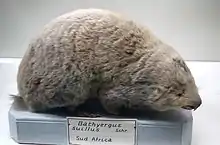

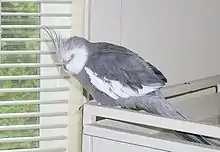
_02.jpg.webp)
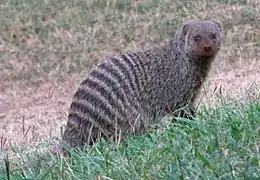
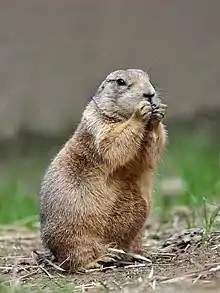

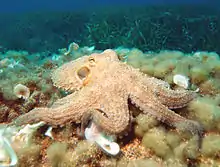

.jpg.webp)
.jpg.webp)






.jpg.webp)

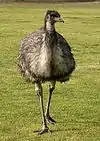


.JPG.webp)
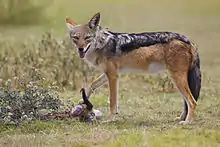
.jpg.webp)
.jpg.webp)

_(8).jpg.webp)
